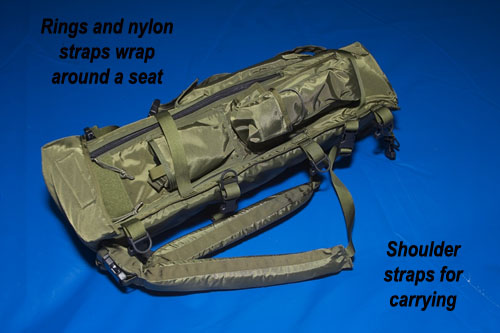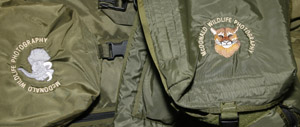

John Stanford, the creator of the Vested Interest Photo Vest (and former owner of that company), is indeed an originator, producing the Molar Bag (available at our office) and a new product that I'm very happy to report that I had a hand in designing - what I call the Ultimate long lens bag, and that John markets more modestly as the Long Lens Bag.
Mary and I are on safari for several weeks each year -- sometimes spending as much as three months on safari. We've tried all sorts of lens cases and concoctions for safely carrying, and using, a long lens, but we've always been frustrated. A few years ago I suggested to John that he make a bag that would meet the needs not only of safari-goers but also photographers shooting from vehicles at home or who need to carry a long lens and camera in the field or from point A to B.
The lens case I envisioned would accommodate a telephoto lens with the lens hood extended, with a camera mounted, and with enough room to fit a tele-converter or extension tubes. Accessory pockets for items needed FOR A TELEPHOTO SHOOTER, like pockets for tele-converters and extension tubes, a flash, and a pocket for a tele-flash (better beamer/visual echoes tele-flash -which we sell from the office) were also needed. John added these pockets, and two more for storing smaller items and the nylon straps you can use for attaching the lens bag to a seat.
Left: The 500mm Long Lens bag with its contents spread out, with arrows indicating where each piece goes. The bag is tall enough to accommodate a lens with the hood attached, as well as a tele-converter or extension tubes.
On safari, we use the long lens bag (OK, call it the McDonald Safari Bag) by standing it upright and then attaching it to the back of the vehicle seat via the nylon straps that encircle the seat back and snapping into the quick lock snaps. John has included several extra straps and lock-snaps for further securing the lens - I often use one or more of these to encircle the lens bag tightly when I'm transporting the bag so that a porter doesn't tip the bag over and perhaps have an accident with the lens falling out! John has added a 2" velcro-edged lid to the bag amd a sturdy quick-release snap-lock for the lid, further securing the bag and making it fairly weather-proof for the type of use we normally put the bag through. He also added very heavy-duty shoulder straps for wearing the bag, and a large, heavy duty snap-lock and strap for carrying the bag or moving it.



John has also added a plastic back stiffener so that the lens stands upright when empty, and doesn't slouch down when a lens is slid in or out. But unlike other long lens bags, this bag collapses to a near flat position, so that it can be packed in a suitcase empty, if desired, or filled with clothes or, as we often do, our headless tripods that we pack into our checked baggage when flying.
The McDonald Long Lens Safari bag acts like a lens holster for us, where we can unzip one, two, or all four zippers open enough so that the lens easily slips into our out of the bag. John placed four zippers in the bag, allowing it to unfurl sort of like a peeled banana, so that the lens can be removed when its lying flat as well, as you very well may carry it when you're shooting from a vehicle. We envisioned a bag that would work upright - pulled straight up, or would work when lying down, as would be the case here in the states if we were shooting from a car or pickup and we had the lens lying beside us on the seat.

John custom makes each bag, and he can probably accommodate any request that you might dream up -- although after three years or so of field testing and continual refinements from me, Mary, and a few others who had to get the prototype -- they wanted that bag! - I can't imagine you'll have much reason to add anything to it. The bag is available in several sizes, and the 500mm bag sells for $250, and the 600mm for $265. They can be ordered directly from John at (972) 395-3458, or johnstanford@vertexphoto.com or Vertex Photographic, 1610 Brighton Drive, Carrollton, TX, 75007, or www.vertexphoto.com
Western
Digital portable external Hard Drives
CS3 Upgrade
Framing with a Telephoto Against a Desert Sunrise
Adobe
Photoshop LIGHTROOM
Workflow
and Workload - You Can Keep Ahead
Bring
along a Point N Shoot
Backing Up Your
Digital Files - you'll need more than you think
Action
Wildlife Photography Camera Settings
HELICON FOCUS
Filter maximizing depth of field digitally
Capture 1's
Most Useful Features
DIGITAL
Photographing scenes with extreme exposure values
Effective
Cloning in Adobe CS2
Watch Your Backgrounds
- The potential of composites or shooting in RAW format
DIGITAL
-Shoot for the Future
DIGITAL-Shoot
for the Future, Part II
The
Helicon Focus Filter Revisited
Frankly
access your skills before deciding upon a workshop
The Songs of Insects - a super book on katydids, cicadas,
and grasshoppers
A
Great Insect Field Guide
Action
Wildlife Photography Camera Settings
The
Pond-A Must-See shooting Location in southern Arizona
Don't
take in baby wild animals
Seize the Moment!
Take
a Workshop First
Luck, what is it?
At the Pulse
of Life by Fritz Polking
Carry-on
Luggage for small commuter flights
Positioning your Roll-on
Carry-On bag
New
Lens Covers for Long Lenses
The
Best All-Around Lens
Keep Your Head Up
Save Your Equipment from
Crashing!
The L-Bracket,
the ultimate camera bumper
Visual
Echos Tele-Flash for the 580EX Flash
Testing
your Flash's Aim
The Ultimate
Flash Bracket
Using
TTL flash with Hummingbirds
Specular
highlights and the flashing frog
Geared Focusing Rail
for Macro Work
Shooting
in Inclement Weather
Low
level tripod work
Sighting in a very, very
long lens
Padding
Your WimberleyTripod Head
Using The Wimberley
Gimbal head with a camera body
Wimberley
400 and 600mm IS plate
How
do we protect our gear from dust, and carry our gear when on safari
How do
you shoot the Moon?
If
you see it, it's too late -- a lesson in anticipation
Protecting
your long lens from SAND, the pleasures of beach photography
Maximum
Depth of Field and Hyperfocal Distance - they're not the same
thing!
A
great depth of field guide
Carry Your Gear!
Custom Function 4-1
for Nikon and Canon shooters
Sigma's 120-300 f2.8
APO zoom telephoto lens
A Car Tip
that could Save Your Life
A Great Website for Information
- the Singapore Nature Photography Society
Airline
Carry-On Luggage -Let your concerns be heard!
Ask Questions Before You
Go
Liquids
in your Levels - TSA Warnings!
Disconnect
-- travel precautions
Photograph America
Newsletter
Obey
the Rules
Wildlife
Portraiture
Drying out boots
with newspaper
Removing
Cactus Spines
The
Ti Chi Stalk
Photographing
Critically Endangered Sites
The Sibley
Bird Guides